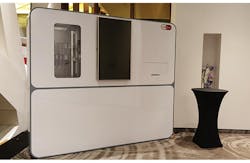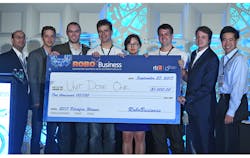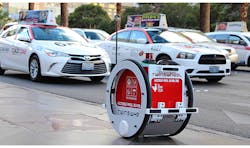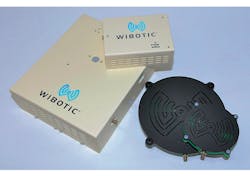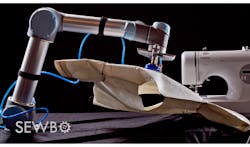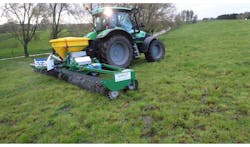The 2017 Robobusiness conference held what’s called a Pitchfire session, which exposed a handful of emerging robotic companies to venture capitalists. The companies had five minutes to pitch their product and company to a panel of judges. It was followed by a short Q&A. Although it’s certainly not a way to pick a long-term winner, it does a good job of revealing new technologies and approaches to attendees.
1. UnitDoseOne dispenses drugs. It’s designed to streamline hospital prescription delivery.
The winner was UnitDoseOne, which essentially is a robotic pharmacy (Fig. 1). It targets hospitals with a slightly different delivery granularity than a typical pharmacy that packages prescriptions for days to months. Hospitals work on an individual basis, so it could be coupled with something like Aethon’s intralogistics automation platform for hospitals.
The winning Unit Dose One team.
Coming in second was TwinswHeel with an autonomous parcel delivery droid (Fig. 2). It normally cruises at 7 km/h, but can go much faster. The droid is able to follow a person using optical recognition rather than following a dongle or smartphone. It can also operate autonomously for delivery to remote locations. The two-wheeled robot can jump curbs (it can’t yet climb stairs, though), and its design allows it to pivot in place for operation in tight confines. The robot has a LIDAR sensor mounted on top.
2. The TwinswHeel autonomous parcel delivery droid features a 10-km range and over 40-kg payload.
Coming in third was Wibotic with its wireless power solution (Fig. 3). It targets fleet-level charging applications, including robotic platforms from wheeled robots to quadcopters. There’s even a packaged landing pad for UAVs equipped with Wibotic’s wireless-charging technology. Its system doesn’t require the alignment needed by some of its competitors.
3. Wibotic’s wireless-power solution targets fleet-level charging applications.
The judges had their own reasons for choosing the winners. The results may have been close, but the other five participants presented interesting and viable solutions as well. All highlight the growing importance of robotics.
C2RO
C2RO is a cloud-based platform for controlling robots. It is software-as-a-platform (SaaS) that puts most of the smarts into the cloud. C2RO has a couple of requirements, such as wireless communication between the cloud and the robots. Though control-loop speed is limited due to the wireless communication, robots still handle high-speed control such as drive motors. The robots actually run the robot operating system (ROS).
What C2RO does is provide more advanced object and facial recognition, as well as mapping and autonomous navigation support. Multi-robot collaboration becomes easier since all of that processing is done in the cloud and not on individual robots.
C2RO has some interesting advantages, such as ease of deployment. It also runs the latest software, so all robots are up-to-date. Furthermore, it can handle 3D cameras/sensors like Kinect.
Gaining Traction with Tractors
Rabbit Tractors looks to deliver a swarm of smaller tractors for farmers. Larger farms have led to larger tractors that can cover larger areas more quickly. Unfortunately, a number of problems arise with larger platforms.
A major issue is soil compaction due to the heavier machinery. The loss due to soil compaction can be as much as 15%. Another problem is transportation between locations, including storage. Using roads means slow movement because tractors aren’t designed to keep up with a Tesla. They also take up lots of space that can frustrate other car drivers.
Rabbit Tractors’ smaller platforms fit on a trailer or pickup truck, allowing them to be moved on highways. Of course, there are more to move but this also works to an advantage, since the loss of one doesn’t stop the overall operation and scaling up or down can be done by adding or removing tractors.
The trick is an operator doesn’t ride in any of the tractors. A single operator manages a swarm of robot tractors from a laptop with the ability to remotely control a tractor when necessary. They would usually operate autonomously.
Saving Stitching Time
Did you know that all clothes are made by hand? I didn’t. Actually, sewing machines and other tools are used, but they all require individuals to make individual items. The main problem is that the materials used in clothing are hard for robots to handle.
4. Sewbo applies a stiffening agent to the materials so that existing robotic and sewing machines can be used autonomously.
Sewbo plans to change things by using a stiffening agent on the materials. This turns a floppy piece of cloth into a solid plank. This makes an object easy to pick up and position by existing robotic technology (Fig. 4) for use with existing sewing machines.
The Sewbo agent washes out with water, which limits the type of materials that can go through this process. Still, the majority of materials used in the clothing industry will work with this technique.
How Now Cow?
Pastoral Robotics Spikey (Fig. 5) takes on cow urine. That turns out to be an issue where there are lots of cattle, because this refuse causes problems on the ground, so to speak. One way to address the problem is to neutralize the urine, which is Spikey’s job. The robot recognizes where the urine has been deposited and sprays ORUN, a chemical that neutralizes the undesirable properties of the urine patch.
5. After Pastoral Robotics’ Spikey locates a patch of cow urine in a field, it sprays ORUN that neutralizes it.
Smooth Robotics takes on heavy-duty welding that’s not part of a larger assembly line. Such welding is only done by people at this point, and it’s not necessarily the safest job around. The Smooth Robotics approach is a similar training system used by other cobots. An operator traces where the weld will go, and then the robot repeats it with the welding tool. The trick, for now, is no other company is addressing the market, and strapping on welding tools to existing cobots is not an option.
Some of these companies may disappear in the long run, while others may emerge as dominant players in their markets. They do highlight the range of applications now being targeted by robots, as well as the level of autonomous operation.
About the Author
William G. Wong
Senior Content Director - Electronic Design and Microwaves & RF
I am Editor of Electronic Design focusing on embedded, software, and systems. As Senior Content Director, I also manage Microwaves & RF and I work with a great team of editors to provide engineers, programmers, developers and technical managers with interesting and useful articles and videos on a regular basis. Check out our free newsletters to see the latest content.
You can send press releases for new products for possible coverage on the website. I am also interested in receiving contributed articles for publishing on our website. Use our template and send to me along with a signed release form.
Check out my blog, AltEmbedded on Electronic Design, as well as his latest articles on this site that are listed below.
You can visit my social media via these links:
- AltEmbedded on Electronic Design
- Bill Wong on Facebook
- @AltEmbedded on Twitter
- Bill Wong on LinkedIn
I earned a Bachelor of Electrical Engineering at the Georgia Institute of Technology and a Masters in Computer Science from Rutgers University. I still do a bit of programming using everything from C and C++ to Rust and Ada/SPARK. I do a bit of PHP programming for Drupal websites. I have posted a few Drupal modules.
I still get a hand on software and electronic hardware. Some of this can be found on our Kit Close-Up video series. You can also see me on many of our TechXchange Talk videos. I am interested in a range of projects from robotics to artificial intelligence.

